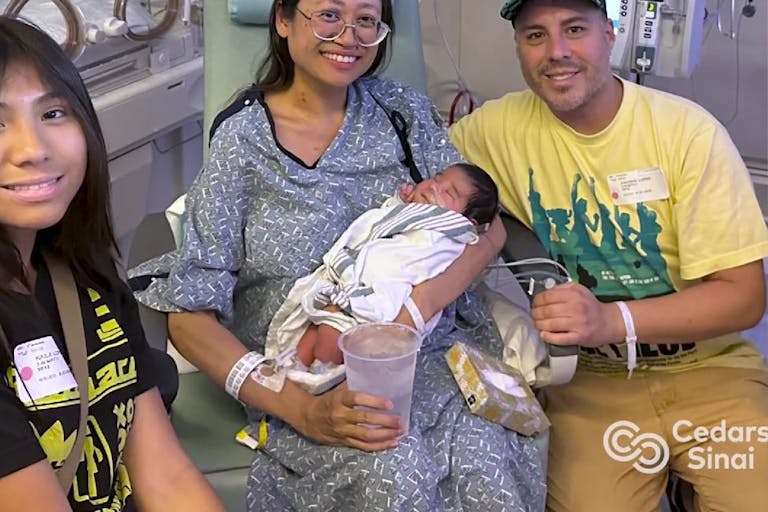
Full term 'miracle' baby born after 'unprecedented' ectopic pregnancy
Bridget Sielicki
·
Up to one in ten preborn babies may survive the feticide injections meant to kill them
In later abortions, a feticide is often used to ensure a preborn child dies before an abortion is completed, especially after 24 weeks when preborn children have a better chance of surviving outside the womb. A feticide is a substance that is injected days prior to completion of a late-term abortion in order to stop the heart of the child. However, new evidence shows that the most commonly used feticide — digoxin, which is actually a heart medication — is both painful and invasive when administered to the woman, and fails to stop the baby’s heart up to 10% of the time.
Health risks
Digoxin is used off-label by the abortion industry to cause cardiac arrest in the preborn child, primarily to to avoid a live birth. An abortion is not successful if a baby is born alive, and a living newborn is a big problem for an abortionist. However, abortionists have admitted that digoxin carries significant risks for the mother.
Paperwork from the late-term abortion business Southwestern Women’s Options lists possible complications associated with digoxin, including allergic reactions, shock, infection, injury to the mother’s organs, blurred vision, vomiting, confusion, and death. According to a study published by the National Institutes of Health (NIH), there is also a risk of spontaneous abortion and infection with the need for hospitalization. According to Abortion on Trial, the risk of hospitalization for the mother increases six times after the use of digoxin in abortion.

In the case of Whole Woman’s Health v. Paxton, the Fifth Circuit Court of Appeals found that the use of digoxin is “painful and invasive” for women during abortions. It stated that using digoxin can be risky for women, listing “heightened risk of infection, hospitalization, and extramural delivery — the unexpected and spontaneous expulsion of the fetus from the uterus while the woman is outside of a clinical setting and without the aid of a medical professional.” Based on this information, the Fifth Circuit agreed with the district court that digoxin is “not a safe and viable method of inducing fetal demise…” And yet, the abortion industry uses it despite its risks to women — and the risks that babies may be born alive during abortions. This is significant, as currently there are no federal penalties if an abortionist chooses not to provide medical care for such infants.
Keisha Atkins was 23 years old when she died from sepsis four days into the process of an abortion (estimated to have been around 24 weeks). She had been given multiple drugs throughout the process, including digoxin. According to the NIH, 1 mg of digoxin is enough to cause fetal death, as its study participants had no adverse maternal events at this dosage level and a 0.5 mg dose had a higher failure rate in causing fetal death. However, Dr. Daniel Poor wrote for St. Joseph’s Health Center that abortionists typically dose 1 – 3 mg. Atkins received 2 mg of digoxin.
Failure rate
If women go into labor before the final day of the abortion process, they are instructed to call the abortion business and leave their hotel room door unlocked to wait for the abortionist or abortion staff to arrive. Southwestern Women’s Options tells women:
If we can’t catch it [delivery of the dead baby – the final stage of the abortion procedure] early enough, which has happened… then you’ll want to unlock the door to the hotel room, get your cell phone, and just sit on the toilet. You don’t have to look at anything … you can stay on the phone with us until the doctor and nurse get there[.]
If the digoxin has failed to kill the baby, women may give birth to their living child, who may be capable of surviving. Babies born as young as 21 weeks have survived and are now healthy young children.
The Fifth Circuit concluded that digoxin fails to ensure the child’s death 5-10% of the time. A study published by the NIH confirms this, finding that the “overall rate of failure to achieve fetal demise was 6.6%.” Failure rates fluctuate depending on the dosage and administration of digoxin.
READ: Reports from just five states reveal over 100 babies born alive during abortions in recent years
Article continues below
Dear Reader,
Have you ever wanted to share the miracle of human development with little ones? Live Action is proud to present the "Baby Olivia" board book, which presents the content of Live Action's "Baby Olivia" fetal development video in a fun, new format. It's perfect for helping little minds understand the complex and beautiful process of human development in the womb.
Receive our brand new Baby Olivia board book when you give a one-time gift of $30 or more (or begin a new monthly gift of $15 or more).
Despite this, the abortion industry routinely denies that babies survive abortion attempts, and lawmakers continue to ignore the evidence. According to the Centers for Disease Control and Prevention, between 2003 and 2014, at least 143 babies are known to have initially survived abortions. Very few states actually report the number of infants who survive abortions, so it is likely that the numbers are much larger than what is currently believed.
Years ago, Baby Rowan was accidentally born alive during a 22-week abortion. His mother Angele recalled the heartbreaking experience. “I started sobbing and lay down [on] the floor,” she said. “I stared and stared at my son. I was horrified that I had just had him in a commode. His right leg moved. He curled up a bit like he was cold; I screamed [for help]! No one came.” The digoxin had failed, yet no one from the abortion business helped Rowan, and left him to die despite his mother’s pleas for someone to call 911.
Selling the body parts of aborted children
Using digoxin despite the health risks to women benefits abortionists because it lowers the risk of a baby being accidentally born alive. However, abortionists are sometimes willing to take the risk if they stand to make more money by not ensuring the baby’s death beforehand. This fact was exposed when the Center for Medical Progress (CMP) made undercover recordings of conversations and interactions with Planned Parenthood abortionists at their facilities.
Undercover journalist David Daleiden said he had interviewed various experts for background during his investigation, having “extensive conversations with neurobiologist Dr. Hurlbut, stem cell scientist Dr. Deisher, and Dr. McCurdy.” Based on those conversations, CMP stated that “a fetus needed to be born alive in order to collect the specimen required for research.”
During the court hearings following the release of the videos, abortionist Dr. Forrest Smith took the stand in support of CMP investigators, testifying that there is “no question” some babies are born alive during abortions in order for the purpose of harvesting their organs.

The most commonly used second-trimester abortion procedure is the D&E dismemberment abortion in which a child is literally dismembered in the womb and her skull is crushed. A video released in 2020 by Pro-Life San Francisco (above) revealed that preborn babies who are going to be used for fetal tissue experiments must be healthy, so they are not given digoxin prior to being dismembered and are therefore alive at the moment their limbs are torn from their bodies.

Planned Parenthood Gulf Coast’s Tram Nguyen admitted under oath that some of the babies come out “almost too intact,” meaning “all of the limbs were completely attached to the torso.” In addition, Perrin Larton, Procurement Manager for Planned Parenthood’s procurement partner Advanced Bioscience Resources, Inc, admitted under oath that she “can see hearts that are not in an intact POC [product of conception/baby] that are beating independently.”
Abortion is always a moral wrong that is deadly for babies and dangerous for women. Babies are violently killed through abortion, and often those who survive are either left to die or are sold piece by piece to researchers. Meanwhile, their mothers often suffer emotional trauma and an increased risk of depression, alcohol/drug use, and suicide, along with physical effects which can sometimes lead to hospitalization, additional surgery, and death.
“Like” Live Action News on Facebook for more pro-life news and commentary!
Live Action News is pro-life news and commentary from a pro-life perspective.
Contact editor@liveaction.org for questions, corrections, or if you are seeking permission to reprint any Live Action News content.
Guest Articles: To submit a guest article to Live Action News, email editor@liveaction.org with an attached Word document of 800-1000 words. Please also attach any photos relevant to your submission if applicable. If your submission is accepted for publication, you will be notified within three weeks. Guest articles are not compensated (see our Open License Agreement). Thank you for your interest in Live Action News!

Bridget Sielicki
·
Analysis
Angeline Tan
·
Analysis
Cassy Cooke
·
Politics
Madison Evans
·
Opinion
Nancy Flanders
·
Investigative
Carole Novielli
·
Issues
Nancy Flanders
·
Human Interest
Nancy Flanders
·
Investigative
Nancy Flanders
·
Pop Culture
Nancy Flanders
·
Human Interest
Nancy Flanders
·